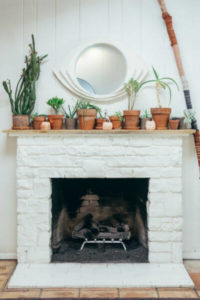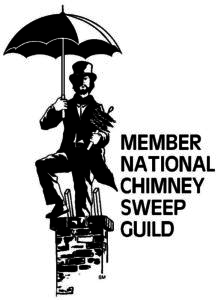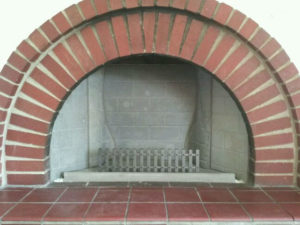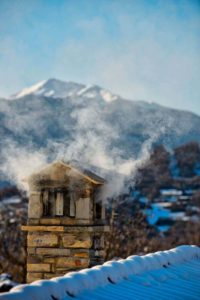There are a number of ways to spot that your fireplace system needs to be repaired; crumbling exterior masonry, leaks, unpleasant odors, or fires that don’t burn correctly are just a few signs that it may be time to call a chimney sweep. However, there is one part of the fireplace that is often ignored, but may need to be repaired – the firebox.

The firebox of your fireplace is built to withstand extremely high temperatures, direct heat from flames, the accumulation of soot and ash, and exposure to smoke and other byproducts of combustion. While extremely sturdy and durable, there are a number of things that can cause damage to the firebox. Because the firebox plays an important role in protecting the surrounding building materials from heat transfer, repairing firebox damage is extremely important.
Causes of firebox damage
Fireboxes are built using special, refractory masonry; this makes them capable of withstanding high temperatures, direct exposure to flames, and other wear and tear from firewood and fireplace use. While designed to safely contain fires for years, there are a number of ways that fireboxes can be damaged. The following are three of the most common cause of firebox damage.
- Settling. All homes – and therefore all chimney systems – are prone to settling. As time passes, the soil surrounding the home can shift and compress; this causes the home to move, or settle, and can lead to cracks in the foundation, walls, chimney, and firebox. Because settling can occur for decades after a home has been built, cracks in the firebox may appear seemingly overnight and progressively get worse over time. Firebox damage caused by settling is often due to footings that cannot bear the full weight of the chimney system.
- Improper building materials. Because the firebox is exposed to direct heat and flame, it is important that special, refractory bricks and masonry is used. If improper building materials were used during firebox construction, the firebox may deteriorate prematurely; surrounding floors, walls, or building materials may experience heat transfer is the firebox was not correctly built. This type of damage can also be seen if a firebox was built by a contractor instead of a trained mason.
- Exposure to moisture. While fireboxes are meant to withstand high heats, they can be severely damaged by exposure to moisture. Water damage is primarily caused by a leak somewhere in the chimney system, but can also occur if water is used to prematurely extinguish fires.
Rebuilding damaged fireboxes
Damaged fireboxes can make it unsafe to use your fireplace; because of this, it is important to have it professionally repaired as soon as possible. Refractory panels with minor damaged may be able to be replaced without rebuilding the entire firebox. In addition to better containing and reflecting heat from the fireplace, replacing refractory panels can help make an aging firebox structurally sound. The masonry joints in the firebox can be repaired through a process called tuckpointing. Tuckpointing involves carefully removing the damaged mortar before applying new mortar to the joints.
Don’t let a damaged firebox prevent you from enjoying your fireplace this winter. Contact the fireplace experts at Jack Pixley Sweeps today for more information on rebuilding your damaged firebox!
The chimney and fireplace industry is still widely unregulated, especially when compared to other professional groups. Because of this, almost anyone with a truck and brushes can call themselves a chimney sweep. One of the most effective ways to tell professional chimney sweeps is their membership in professional organizations and guilds. At Jack Pixley Sweeps, we are proud to have certified sweeps. We are also proud of our memberships in a variety of professional groups including the National Chimney Sweep Guild (NCSG).
What is the NCSG?
 The National Chimney Sweep Guild is a professional guild for chimney sweeps dedicated to improving fireplace safety, educating consumers, and encouraging professionalism among chimney sweeps. Founded in 1977, NCSG is dedicated to its mission of “inspiring innovation, professionalism and community among chimney sweeps and venting professionals through advocacy, industry leading conferences and journalism, covering people, tools, health, standards, and education for a successful business and the safety of the American people.”
The National Chimney Sweep Guild is a professional guild for chimney sweeps dedicated to improving fireplace safety, educating consumers, and encouraging professionalism among chimney sweeps. Founded in 1977, NCSG is dedicated to its mission of “inspiring innovation, professionalism and community among chimney sweeps and venting professionals through advocacy, industry leading conferences and journalism, covering people, tools, health, standards, and education for a successful business and the safety of the American people.”
What does the NCSG do?
The NCSG aims to increase professional standards for chimney sweeps throughout the country. Through education, members can take part in up-to-date training to keep informed on safety standards in the fireplace industry. The NCSG also holds an annual conference that allows chimney professionals to network, connect, and learn from respected industry professionals. They even go beyond the surface by providing its members with a Code of Ethics to guide their business.
The most important parts of NCSG membership is the Code of Ethics. It is designed to hold chimney sweeps to a higher standard of performance and professional behavior. Homeowners can put their full trust in members of the NCSG. Our members are trustworthy and trained professionals, who really care about fireplace and chimney with the utmost professionalism and care.
Choose a professional chimney sweep!
At Jack Pixley Sweeps, we are proud to be professional, full-time chimney sweeps. In addition to our membership in the National Chimney Sweep Guild, our sweeps are members of other professional organizations including the Builders Association of Minnesota, the Brick Industry Association, and our sweeps are all Chimney Safety Institute of America (CSIA) certified.
Since 1977, we have been providing our friends in the greater Minneapolis area with comprehensive chimney and fireplace care. With more than 100,000 satisfied customers, we are ready to handle everything from annual sweepings to major fireplace rebuilds! Trust the professionals at Jack Pixley Sweeps to care for your heating appliance. Contact us today for more information on how we strive to be “The name you can trust!”
Fireplaces have always been the heart of a home. While they were once used as the primary way to heat a home – and even as a way to cook food! – fireplace are more decorative than in the past. If you are looking for a fireplace that combines both modern style with old-world heating functionality, look no further than Ahrens fireplace systems!
Fireplace aesthetics vs functionality
Many modern fireplaces are designed with an emphasis on aesthetics instead of functionality. While sitting in front of these fireplaces may be pleasant, they may do little to actually add heat to the home. Fireplaces that are not well designed:
- Cause the room to get smoky when not in use
- Make the house seem colder when lighting a fire
- Cause the walls surrounding the fireplace to seem hot when in use
These burning conditions do more than just affect fireplace performance; they can also make it unsafe to use your fireplace.
About Ahren-fire systems
Designed and manufactured in Sioux Falls, South Dakota by the Ahrens Chimney Company, Ahren-Fire fireplaces are made with both form and function in mind. In addition to looking nice, Ahren-Fire fireplaces are designed to radiate heat back into your home. These all-in-one systems include everything from the firebox to the flue; when professionally installed in place of an existing fireplace, they can help solve a number of performance and safety problems.
The unique design of Ahren-Fire fireplaces heat your home with minimal heat loss up the chimney. Likewise, their design creates optimal drafting and prevents smoke from blowing back into your home. Ahren-Fire fireplaces are also the only restoration fireplace product to meet or exceed the stringent safety testing criteria by Underwriters Laboratory.
Benefits of Ahren-fire fireplaces
When an existing masonry hearth fireplace does not meet current building codes, it can be unsafe to use. In addition to fireplace performance issues such as incorrect drafting or not creating enough heat, hidden hazards such as combustible materials around the hearth or incorrect thickness of the masonry can also be present. Investing in and having a complete, all-inclusive Ahren-fire fireplace system professionally installed can give you peace of mind that all of your chimney components not only meet current building standards, but work together to improve the safety and efficiency of your fireplace.
Installing a new Ahren-fire fireplace
Ahren-fire fireplace systems are designed to be easily installed into an existing masonry hearth. With eight different size options, homeowners can find the perfect fit for their hearth. Ahren-fire systems are an excellent alternative to wood burning inserts; they improve safety and efficiency without losing the true wood-burning experience. This allows homeowners to safely enjoy the heat, sights, sounds, and smells of their wood burning hearth once again.
At Jack Pixley Sweeps, we are proud to install Ahren-Fire fireplace systems for our customers. For more information on these safe and efficient alternatives to wood-burning inserts, or to learn how they can help bring your older fireplace back to current building standards and codes, contact us today!
Did you just install a new fireplace or stove in your home? If so, there is one more step to the installation process before your new heating appliance is safe to use – the smoke test.
What is a smoke test?
 A smoke test, or a chimney pressure test, is required by the National Fire Protection Association Standard 211; the test should be performed by a professional after installing a new fireplace or stove. This test is designed to identify any defects, flaws, or problems in your fireplace system that might allow smoke, gas, or dangerous fumes to leak into your home. Likewise, the smoke test also ensures that your chimney is drafting correctly and if the flue needs to be relined or not.
A smoke test, or a chimney pressure test, is required by the National Fire Protection Association Standard 211; the test should be performed by a professional after installing a new fireplace or stove. This test is designed to identify any defects, flaws, or problems in your fireplace system that might allow smoke, gas, or dangerous fumes to leak into your home. Likewise, the smoke test also ensures that your chimney is drafting correctly and if the flue needs to be relined or not.
The process of a smoke test
During the first part of a smoke test, the chimney professional try to establish correct flue draw. To do this, a blowtorch is used to light a smoke pellet that produces a distinctive odor. Once smoke is seen coming out of the top of the chimney, the next phase of the smoke test begin.
After establishing flue draw, the chimney technician seals the top and bottom of the flue along with doors, ash pit covers, and vents. Once the entire chimney is sealed, the technician begin checking the inside and outside your home for signs of a leak. This includes checking rooms adjacent to the chimney, all sides of the chimney, and even adjacent attic and roof spaces. If any leaks are found, recommendations are made on solution for repairs.
The importance of smoke tests
A smoke test might seem like an unnecessary step, especially if your fireplace is newly built and professionally installed. However, this safety test is an important part of ensuring your fireplace can burn safely. A smoke test ensures the chimney has correct flue draw and no leaks, it also helps to prevent future draft and smoking issues. Likewise, it also significantly reduce the chance of chimney fire or carbon monoxide poisoning in the future. This make your new heating appliance safer to use and give you peace of mind for years to come.
Maintenance after a smoke test
While a smoke test is an important part of preparing to use your new fireplace, it is not the only maintenance your appliance needs. Annual maintenance is the best way to ensure your fireplace continues to burn safely and efficiently year after year. An annual chimney sweeping removes blockages and buildup in your chimney; this helps the fireplace to draft correctly and prevents accidental chimney fires.
Annual inspections are also an useful tool in identifying damage or deterioration before they cause serious problems. If you just installed a new heating appliance or built a new chimney, it is important to perform a smoke test to ensure it is drafting safely. For more information on smoke tests, schedule your appointment today by contacting Jack Pixley Sweeps today at 763-422-0481.
Spring and summer are the nesting season for many animals. While you may enjoy seeing birds nests in your trees or a rabbit den in the backyard, there is one place you do not want animals to nest – in your chimney.
Many birds and small mammals view a chimney as the perfect place to nest and protect their young. While the chimney is a cool, dark, protected, and enclosed space, it can be dangerous and difficult to navigate for many animals. Likewise, animal entry can cause significant damage to your chimney system. Because of this, it is important to have animals removed as soon as possible.
How Animals Get In
The most common ways for animals to enter a chimney is through a damaged chimney cap. Birds and small mammals can fit through holes and gaps just a few inches wide; raccoons have been known to use their claws and teeth to tear at the chimney cap in order to create a large enough hole for them to fit through.
The Dangers Of Animals In The Chimney
The presence of animals in the chimney can cause damage to your fireplace system and affect future burning performance. One of the primary ways animals cause damage is to the chimney liner. In addition to scratching it with their claws, teeth, and beaks, nesting materials can also have a corrosive and weakening effect on the liner.
Nesting materials, discarded food, and animal droppings can also create chimney blockages. When dry, these materials can be extremely flammable, increasing the risk of chimney fire if they ignite. The presence of animals can also cause strong odors as well as expose your family to bugs, parasites, or bacteria.
Getting Animals Out
If you have animals in your chimney, it is important have them professionally removed as soon as possible. Working with a chimney company to have the animals removed ensures that not only will the animals and their nesting materials be safely removed, but that minimal additional damage will be done to your chimney.
Not all animals can be immediately removed; chimney swifts and other species of migratory birds are protected by federal law. Removing protected migratory bird nests can come with a hefty fine. Luckily, the nesting cycle for chimney swifts is relatively short; most hatchlings have left the nest in around 6 weeks, allowing homeowners to remove the nests and repair their point of entry after.
Preventing Animal Entry
Once the animals have been removed, it is important to take the steps to keep them from re-entering your chimney. One of the best ways to do this is by finding and securing their point of entry. Installing a new chimney cap, a stainless steel screen, or a rain cover can all help protect against animal reentry.
While it may be fun to spot baby animals out and about in nature, the last place we want to see them is in our chimneys. To protect your chimney against animal entry – or to have animals safely removed – contact Jack Pixley Sweeps today!


 The
The 
 A smoke test, or a chimney pressure test, is required by the
A smoke test, or a chimney pressure test, is required by the